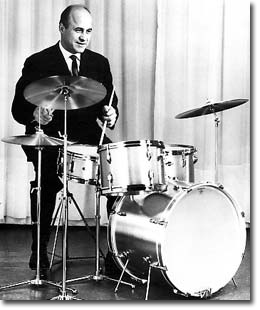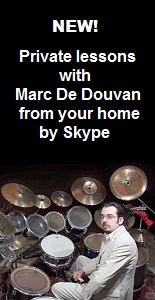
 : : Great drummers
: : Great drummers
- Acuña Alex
- Agostini Dante
- Alexander Tim "Herb"
- Allen Tony
- Ameen Robby
- Appice Carmine
- Aronoff Kenny
- Arpino Thierry
- Barretto Ray
- Belleville Pierre
- Bellson Louie
- Bissonette Gregg
- Blackwell Ed
- Blaine Hal
- Blakey Art
- Bonham John
- Bozzio Terry
- Brown Carlinhos
- Brown Gerry
- Bruford Bill
- Carrington Terri Lyne
- Ceccarelli André
- Cerrone Marc
- Chambers Dennis
- Cinelu Mino
- Clarke Kenny
- Cobham Billy
- Colaiuta Vinnie
- Collins Phil
- Conte Luis
- Copeland Stewart
- Da Fonseca Duduka
- de Grasso Jimmy
- de Johnette Jack
- Diabaté Inza
- Diaz Miguel "Anga"
- Dodds Warren "Baby"
- Donati Virgil
- Dunbar Lowell “Sly”
- Erbetta Marc
- Erskine Peter
- Escovedo Sheila "E"
- Ewandé Louis César
- Fanfant Jean-Philippe
- Foster Al
- Gadd Steve
- Garibaldi David
- Gastaldin Claude
- Gonzalez Jerry
- Gozzo Alain
- Greer Sonny
- Grohl Dave
- Guem
- Gurtu Trilok
- Gustke Ralf
- Hakim Omar
- Haynes Roy
- Hernandez “El Negro” Horacio
- Hidalgo Giovanni
- Higgins Billy
- Hoglan Gene
- Humair Daniel
- Hussain Zakir
- Jacquin Jean-Christophe
- Jimbo Akira
- Jones Elvin
- Jones "Philly" Joe
- Jones « Papa » Jo
- Jordison Joey
- Katché Manu
- Keita Mamady
- Kolinka Richard
- Krupa Gene
- Lake JR Oliver Gene
- Lang Thomas
- Latham Rick
- Mac Brain Nicko
- Mason Harvey
- Mattalia Alessia
- Mayer Jojo
- Michelino Silvano
- Minnemann Marco
- Mitchell John "Mitch"
- Mocidade Independente de Padre Miguel
- Moeller Sanford
- Moreira Airto
- Morello Joe
- N'Diaye Rose Doudou
- Oxley Tony
- Paice Ian
- Paolini Jean-Claude
- Parker Leon
- Peart Neil
- Phillips Simon
- Poleo Orlando
- Porcaro Jeff
- Portnoy Mike
- Pozo Chano
- Priester Aquiles
- Puente Ernesto « Tito »
- Purdie Bernard "Pretty"
- Quintana Jose Luis "Changuito"
- Rekow Raul
- Renaudin Bertrand
- Rich Buddy
- Roach Max
- Roddy Derek
- Samba Mokhtar
- Sanchez Poncho
- Santamaria Mongo
- Séry Paco
- Smith Chad
- Smith Marvin “Smitty”
- Smith Steve
- Sorum Matt
- Starr Ringo
- Stewart Bill
- Stubblefield Clyde
- Temiz Okay
- Terrana Mike
- Top Secret Drum Corps Basel Suisse
- Ulrich Lars
- Vander Christian
- Wassy Brice
- Watts Charlie
- Watts Jeff
- Webb Chick
- Weckl Dave
- White Lenny
- Wilk Brad
- Williams Tony
- Ziad Karim
Agostini Dante
Musicians or bands:
Jacques Hélian, Tino Rossi, Luis Mariano, Charles Trénet
Biography and commentary:

Born in 1921 in Italy, Dante Agostini starts drums and accordion at 5 years old. He became the drummer for the Olympia and the Folies Bergeres (famous Music Halls in Paris), where he accompanied the 50s "pop stars". Fan of bebop and Kenny Clarke , his principal inventor, based in Paris (Kenny also inspired one of the most important American modern drumset methods: "Advanced Techniques for the Modern Drummer" Jim Chapin, 1948), Dante self publishes his first method of "modern" drums (not "classic" or military drums, with a musician by instrument, the first in France), in 1967, by being co-author with Kenny Clarke. This will be the beginning of a long series, until his death in 1980. He opened the first drumset school in France (in Paris, 1964), with the support of Kenny Clarke, who became his friend, and later followed by the opening of multiple others. With his first students (including Bertrand Renaudin , who suggests to him notably the universal writing of the fingering (right / left) with circles and dots), he develops his first handwritten scores. Although quite pioneer (with a lot of drumming of rock of the origins (1950)), I reckon that his methods are now outdated notably because of their ahistorical approach, few explaned, few ordered, very focused on snare drum alone, the reading of long pieces (while all the modern drummers improvise, from the origins of modern drumset), jazz and rock, omitting the double bass drum, the Afro Latin cultural heritage (Cuban, Brazilian, Caribbean, etc. often distorted or missing), and funk (fusion, jazz-rock, hard rock, with the use of ghost notes) already very present in 1960-70 and quite inevitable for a "good" modern drummer worthy of the name today. The Agostini "method" offers finally very few original and creative musical concepts, and a quite limited culture of the instrument, with an approach that I find not very effective and "enslaving" (reading pieces note for note with many redundancies, instead of describing vocabulary, an improvisation or composition system, which also justified its extraordinary volume). All of this probably explains that across the Atlantic (in America), the Agostini methods have had very little success. My own methods attempt to remedy all these lackings, like the most of the recent and even old American methods (such as the first modern drums method of Gene Krupa, in 1938, with all the american drum rudiments (unlike Dante Agostini) and basic extensions on one drum (including non-military syncopated rhythms, typical of jazz), and the whole set, the "Moeller" technique with explained photos and historical solos). Finally, I point out that Ted Reed, a teacher in a music school in Broadway, published in 1958 (9 years before the first Agostini method) an almost not yet existing method in its kind (designed first for his own jazz drums pupils), entitled "Progressive Steps to Syncopation for the Modern Drummer", which I find really very similar to many Agostini methods: rhythmic exercises (but without fingering, which may explain the still current success in the US of "Stick Control for the Snare Drummer" from G.L. Stone (1935), focused on this subject) plus a much more ordered (and therefore really progressive) and logical construction (based on combinatorial mathematics, to take into account all possibilities and access to a total freedom in playing, an approach that I adopted myself but in an even more mathematical and condensed way, and with a lot of explanations and developments on possible applications for modern drumset, which Ted Reed omits completely). You must know, however, that the first drum method in the world, “Orchésographie” (1588), written by a French, Thoinot Arbeau, to describe dance music, dance and military music and its use, already presents a combinatorial mathematics rhythmic approach (also without fingering giving a free interpretation according to the tempo, the technique and the desire of the player, without description of the rudiments which were transmitted orally at first, and will be described in very subsequent methods). A year later, Ted Reed published again a method called "Drum Solos and Fill-ins for the Progressive Drummer" (only in a very classic jazz style and this time with complete fingerings but very basic and not typical of jazz) which could have also served as a model for Dante. At the time of its publication, this method was probably a good addition to the aforementioned Jim Chapin method, which deals only with the issue of independence in Be-Bop jazz drumming. On the contrary, Ted Reed methods are still best sellers in the US, which may seem deserved given their anteriority and ordered (mathematical and thus universal) and synthetic aspect. However they are also very basic and in my opinion clearly insufficient in terms of educational information on modern drumset today, particularly in terms of culture, because music (implied "creative" for me) can not be limited to mathematics and some few old references (again, his methods don't absolutely tackle the Latin rhythms and double bass drum, or the funk style, because later, and a host of yet rudimentary concepts in modern and even classical drums).
Marc De Douvan, publication in French: March 3, 2009 (for the translation in English: July 12, 2015)
Official website
See© 2005 Marc de Douvan Crédits Mentions légales
